Abstract
Triboelectric nanogenerators (TENG), which convert mechanical energy (such as ocean waves) from the surrounding environment into electrical energy, have been identified as a green energy alternative for addressing the environmental issues resulting from the use of traditional energy resources. In this experimental design, we propose rolling spherical triboelectric nanogenerators (RS-TENG) for collecting energy from low-frequency ocean wave action. Copper and aluminum were used to create a spherical frame which functions as the electrode. In addition, different sizes of spherical dielectric (SD1, SD2, SD3, and SD4) were developed in order to compare the dielectric effect on output performance. This design places several electrodes on each side of the spherical structure such that the dielectric layers are able to move with the slightest oscillation and generate electrical energy. The performance of the RS-TENG was experimentally investigated, with the results indicating that the spherical dielectrics significantly impact energy harvesting performance. On the other hand, the triboelectric materials (i.e., copper and aluminum) play a less important role. The copper RS-TENG with the largest spherical dielectrics is the most efficient structure, with a maximum output of 12.75 V in open-circuit and a peak power of approximately 455 nW.
1. Introduction
Innovative technologies have been developed to extract mechanical energy from the environment and convert it into electrical energy, including electromagnetic, electrostatic and piezoelectric methods [1,2,3,4,5,6,7,8,9,10,11]. Ocean wave action makes up a significant part of the ocean’s energy, and is estimated to be around 2–3 TW along coastlines worldwide [6]. In recent years, triboelectric nanogenerators (TENG) with the benefits of high power density, light weight, etc., have been developed as a green energy technique for energy harvesting under various application scenarios [12,13,14]. TENG technology advancements have resulted in a wide range of applications, including self-powered biomedical devices (e.g., electronic skins, mechanical communication systems, and wearable systems), self-powered engineering devices (e.g., temperature fluctuation and structural vibration sensors), and various other sensing devices (e.g., motion vector sensing, wearable sensors, driving monitoring, fish bladder film-based position monitoring, self-functional healthcare and monitoring socks, and human–machine interfacing) [15,16,17,18,19]. Triboelectric nanogenerators (TENG) [20] were proposed in 2012 as a new kind of energy harvesting approach. For the first time, in 2014 TENG was utilized to gather wave energy [21]. TENG has a number of advantages over electromagnetic (EMG) generation, including higher power density (up to 3200 W/m2), lower weight, increased productivity (up to 70%) and lower production costs [6]. It is a significant advance in the attempt to collect low-frequency ocean energy. [22,23,24]. Different types of TENG have been constructed and used to harvest ocean energy. [25,26,27,28]. For example, multi-mode magnetic TENG energy harvesting systems were developed using the magnetic oscillation method to oscillate the dielectric capsules. Steel spring connectors were used to increase the oscillation frequency and achieve higher power output [10]. In addition, a spring-assisted TENG was reported to harvest water wave energy by using a spring to increase the power density [29]. Due to the advantages of a light weight, low resistance and ease of integration, a rolling spherical TENG with or without connected networks has been developed to collect ocean wave energy [30,31,32,33,34,35,36,37]. However, the previously-constructed spherical TENG was designed with lever arms or springs to trigger the energy materials and generate electrical power, which critically limits their practical applicability. One available alternative in ocean applications is to change the functioning structure of the TENG by designing rolling spherical versions without assistance to increase the output voltage of mechanical energy from ocean waves and convert it to electric power.
Here, we propose a rolling spherical TENG (RS-TENG) which utilizes a rolling structure and a freestanding triboelectric layer-based process to harvest energy from low-frequency ocean wave action. The RS-TENG is designed by contacting a copper or aluminum film in an enclosed spherical shell with rolling silicon rubber balls, which are light, inexpensive, and capable of floating on the ocean’s surface. Taking advantage of the spherical structures in its the freestanding mode, this RS-TENG system can harvest electrical energy under low-frequency and low-amplitude oscillations. The conducted experiments and results presented here indicate that by increasing the size of the spherical dielectric, output voltage was increased. Therefore, RS-TENG achieved efficient results with SD4. In addition, by increasing the oscillation the spherical dielectric was able to rotate more, allowing the output voltage to be further increased.
2. Results and Discussion
2.1. Structure of the RS-TENG
The design principles of the RS-TENG are illustrated in Figure 1. Figure 1a demonstrates the RS-TENG oscillation scenarios in the copper frame, which are compared to the experimental observations captured by a high-speed camera (see Supplementary Materials Video S1). Figure 1b demonstrates the use of the RS-TENG for ocean wave action with low-frequency and low-amplitude oscillations. The oscillations cause the spherical dielectric in the spherical frame to roll. The oscillation response of the copper RS-TENG with the high-speed camera is provided in Supplementary Materials Video S1. In Supplementary Materials Video S2, the energy harvesting performance of the copper (Cu) RS- TENG is illustrated. Supplementary Materials Section 1 details the equipment and principle of the RS-TENG used in the experiments.
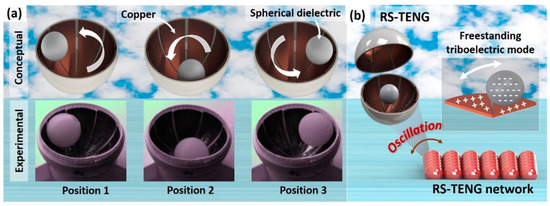
Figure 1.
Structural principle of the RS-TENG: (a) RS-TENG oscillation scenarios in a spherical frame along with a comparison to experimental observations captured by a high-speed camera; (b) the application of the RS-TENG in ocean waves and principle of the copper (Cu) RS-TENG, including the copper (Cu) structure and spherical dielectric.
2.2. Output Performance and Setup of Experiment of the Copper and Aluminum RS-TENG
The RS-TENG were made with copper (Cu) and aluminum (Al) for the various spherical dielectrics. Figure 2a presents the design details of the copper (Cu) and aluminum (Al) RS-TENG. The electrode frame and spherical dielectric were the components made from copper (Cu) and aluminum (Al). The space between each layer was set to 1 mm. In this structure, 3D printing with PLA (Polylactic Acid) materials was used to create spherical frames. Figure 2b shows the manufacturing process of spherical silicon rubber as a spherical dielectric. A high-speed centrifuge was used to create silicone rubber spheres with diameters of 14 mm, 20 mm, 24 mm and 27 mm. The prototypes used in this study as well as the frames and molds of the rolling silicon rubber balls were 3D printed from of PLA (Polymaker-Tough) material using a 3D printer (Ultimaker-S3, Ultimaker Inc., Utrecht, The Netherlands) with a maximum printing size of 223 mm × 223 mm × 205 mm and a maximum printing velocity of 50 mm/s. Figure 2b shows the manufacturing process of the rolling silicon rubber balls with various dimensions as the spherical dielectric. The molds had inner dimensions of , ; , and mm, and outer dimensions of , ; , and , and were also 3D printed from PLA material using the 3D printer. The high-speed centrifuge thoroughly mixed the silicon rubber materials for ten minutes to make spherical dielectric parts. In addition, copper and aluminum tape were added to the frame with a 1 mm gap between each layer to make the electrode parts. The RS-TENG experimental setup is depicted in Figure 2c. A shaking machine was used to generate frequencies of 1.1 Hz, 2.4 Hz and 4.2 Hz for 6 s; voltage signals were collected using a digital oscilloscope. In the RS-TENG design, there are two electrode terminals on the inner surface of the hemisphere. Electrode (Cu/Al) contacts the external load. Layers (4) and (8) were selected as one electrode terminal, and the remaining layers served as another electrode terminal.
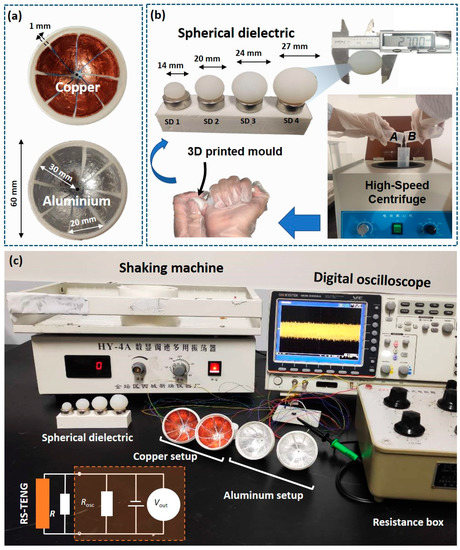
Figure 2.
Fabrication and setup of the experimental RS-TENG: (a) design information of the copper (Cu) and aluminum (Al) frames in the RS-TENG; (b) fabrication of the spherical dielectric in the RS-TENG; (c) experimental setup and testing of the RS-TENG.
Figure 3 shows the effect of the frequency (1.1 Hz, 2.4 Hz and 4.2 Hz) performance on the RS-TENG. The output performance of the copper (Cu) RS-TENG with SD1 in the open circuit (OC) is shown in Figure 3a. The maximum voltage of was obtained at a speed of 4.2 Hz, and the minimum voltage of was obtained at a speed of 1.1 Hz. On the contrary, the output of the copper (Cu) RS-TENG with SD1 in the open circuit at the loading frequency of 2.4 Hz was 3.75 V. The voltage of the aluminum (Al) RS-TENG with SD1 is shown in Figure 3b. A similar voltage output pattern was achieved at a speed of 4.2 Hz, with = 5 V as the maximum output and = 0.75 V at a speed of 1.1 Hz. At a loading frequency of 2.4 Hz, the output voltage of the aluminum (Al) RS-TENG with SD1 in the OC was 3.5 V. The output performance of the copper (Cu) RS-TENG with SD2 in the open circuit is shown in Figure 3c, with the maximum output performance being = 10.5 V at 4.2 Hz and = 1.3 V at 1.1 Hz. The output performance of the copper (Cu) RS-TENG with SD2 in the open circuit at a loading frequency of 2.4 Hz was 7.75 V. The aluminum (Al) RS-TENG voltage with SD2 is shown in Figure 3d. A similar output performance pattern was obtained, with the = 6.25 V at a speed of 4.2 Hz and = 1.1 V at a speed of 1.1 Hz. In addition, the open-circuit output voltage of the aluminum (Al) RS-TENG with SD2 at a speed of 2.4 Hz was 5 V. The output of the copper (Cu) RS-TENG with SD3 is shown in Figure 3e, with = 11.75 V at 4.2 Hz and = 1.3 V at 1.1 Hz. Figure 3f presents the voltage of the aluminum (Al) RS-TENG with SD3; a similar output performance pattern was achieved, with at the frequency of 4.2 Hz and at 1.1 Hz. Figure 3g demonstrates the output performance of the copper (Cu) RS-TENG with SD4; the maximum voltage was under 4.2 Hz and the minimum was under 1.1 Hz. The output of the aluminum (Al) RS-TENG with SD4 is shown in Figure 3h, with the maximum voltage being = 11.25 V at 4.2 Hz and = 1.4 V at 1.1 Hz.
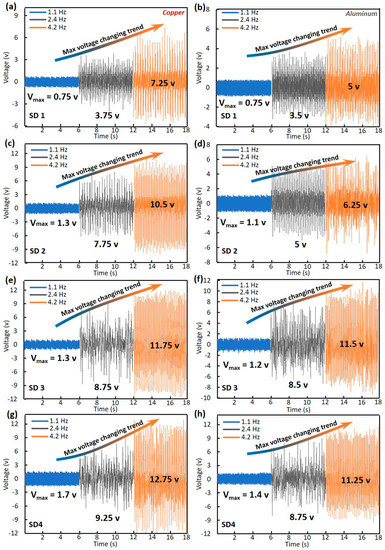
Figure 3.
Effect of frequency performance on the RS-TENG. The RS-TENG output distribution pattern at 1.1 Hz, 2.4 Hz, and 4.2 Hz loading frequencies in (a) copper (Cu) and (b) aluminum (Al) in SD 1, (c) copper (Cu) and (d) aluminum (Al) in SD 2, (e) copper (Cu) and (f) aluminum (Al) in SD 3, and (g) copper (Cu) and (h) aluminum (Al) in SD 4; loading time for all cases was fixed at 6 s.
Figure 4a,b compares the voltage of (a) copper (Cu) and (b) aluminum (Al) in SD 1, SD2, SD3 and SD4 with various frequencies. Figure 4c shows the series of triboelectric materials. The triboelectric effect is the basic strategy for exploring these materials. The fundamental idea behind the triboelectric effect is to construct a triboelectric series based on the charge point when any two materials come into contact through rubbing or pressing. The materials listed in the upper area of the triboelectric group are positively charged, while those introduced in the lower section are negatively charged [38]. The triboelectric series is widely accepted as a primary reference for selecting appropriate materials for TENG. When a triboelectric charge is formed by friction between two different materials, the triboelectric series can predict which side would be negatively or positively charged. In this study, the rolling silicon rubber balls are designed to serve as the dielectric component in the RS-TENG.
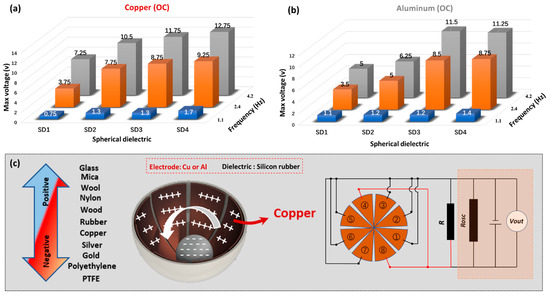
Figure 4.
Comparison effect of the frequency performance on the RS-TENG. Comparison of the voltage of (a) copper (Cu) and (b) aluminum (Al) in SD 1, SD2, SD3 and SD4 with various frequencies; (c) series of triboelectric materials [38].
Figure 5a,b shows the power and voltage of the copper (Cu) and aluminum (Al) RS-TENG, respectively, along with the electrical resistance with spherical dielectric 1 (SD1) at the frequencies of 1.1 Hz, 2.4 Hz and 4.2 Hz. A peak power of approximately 136.9 and peak voltage of 4.5 were obtained for the copper (Cu) RS-TENG, and a peak power of 146.3 and peak voltage of 4.5 were obtained for the aluminum (Al) RS-TENG, with electrical resistance of 100 KΩ to 1 GΩ. Figure 5c,d depicts the power and voltage of the copper and aluminum (Al) RS-TENG, respectively, with spherical dielectric 2 (SD2) at the frequencies of 1.1 Hz, 2.4 Hz and 4.2 Hz. Peak power and voltage were obtained as 253 and 7 for the copper (Cu) RS-TENG and 220 and 7.5 for the aluminum (Al) RS-TENG, with an electrical resistance of 100 KΩ to 1 GΩ. Figure 5e,f presents the power and voltage of the copper (Cu) and aluminum (Al) RS-TENG with spherical dielectric 3 (SD3); the peak power and voltage are, respectively, 330 nW and 9 V for the former and 273 nW and 8 V for the latter. Figure 5g,h provides the power and voltage of the copper (Cu) and aluminum (Al) RS-TENG with spherical dielectric 4 (SD4), with the peak power and voltage being 455 nW and 9 V and 338 nW and 9 V, respectively. There are three ways of writing an equation for power. In this study, the power was obtained as
where and refer to the voltage and resistor.
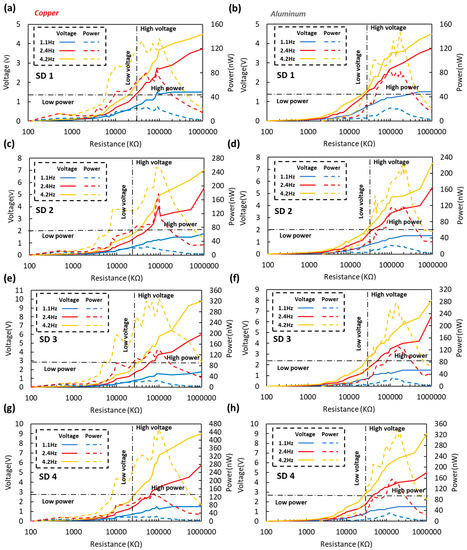
Figure 5.
Output performance of RS-TENG with SD1, SD2, SD3 and SD4. Voltage and power distribution trends of the RS-TENG under the loading frequencies of 1.1 Hz, 2.4 Hz and 4.2 Hz in (a) copper (Cu) and (b) aluminum (Al) in SD 1, (c) copper (Cu) and (d) aluminum (Al) in SD 2, (e) copper (Cu) and (f) aluminum (Al) in SD 3, and (g) copper (Cu) and (h) aluminum (Al) in SD 4.
In this work, rolling silicon rubber balls with a diameter of 27 mm (SD4) in the copper setup proved to be optimal based on output power and voltage. In fact, with an increasing surface of the dielectric, voltage and power increase. In Furthermore, the performance of the copper setup was more efficient than aluminium. In addition to conductivity, the electrode material significantly influences the difference between copper and aluminum TENG. Choosing materials with an enormous energy gap would theoretically result in a higher output voltage. According to the triboelectric series, because silicone rubber is one of the TENG materials in both circumstances, aluminum should provide a larger output than copper. However, we must first consider the conductivity and resistivity of aluminum versus copper. Copper, in general, is a highly conductive metal with low resistance (1.68 × 10−8). On the other hand, aluminum has poorer conductivity than copper and a resistance (2.65 × 10−8) that is nearly 1.5 times that of copper. In other words, with the same size electrodes of both aluminum and copper, aluminum produces a weaker or lower output than copper. Furthermore, the higher output produced by the aluminum–silicone rubber arrangement will be lower than that produced by the copper–silicone rubber design. In fact, with increasing surface contact between the electrode and dielectric, output performance will be increased. There are certain factors which generally affect TENG power generation and transmission, such as the motion parameters (including frequency, amplitude and contact and noncontact motion regimes). In addition, using a sonic array configuration can enhance the performance of the RS-TENG through better design and optimization of the structure of RS-TENG, as will be considered in future studies [39].
3. Conclusions
This design presents a design for rolling spherical triboelectric nanogenerators (RS-TENG) to collect low-frequency ocean wave energy. The nanogenerators were fabricated with copper (Cu) or aluminum (Al) structures and four different sizes of spherical dielectrics (i.e., SD1, SD2, SD3 and SD4). The electrical output performance of the RS-TENG was evaluated through experiments. The results showed that the spherical dielectrics (i.e., SD 1, 2, 3, and 4) had a significant impact on energy harvesting performance, while the triboelectric materials tended to have only a slight effect. The copper (Cu) RS-TENG with SD4 was the most efficient design, with a maximum (OC) voltage of 12.75 V and peak power of approximately 455 nW. The RS-TENG’s innovative use of several electrodes of copper (Cu) or aluminum (Al) in each side of the spherical structure caused the spherical dielectric to move with even the slightest oscillation in order to produce energy.
Supplementary Materials
The following supporting information can be downloaded at: https://www.mdpi.com/article/10.3390/jmse10010005/s1, Figure S1: (a) Loading machine. (b) High-speed camera (Integrated Design Tools) used to record the different scenarios of the RS-TENG. (c) The digital oscilloscope used to measure the output voltage (GDS-2202A Tech. Inc.), Table S1: Material and geometric properties of RS-TENG in the copper or aluminium setup, Video S1: RS-TENG oscillation scenarios in the copper frame. Video S2: Energy harvesting performance of the RS-TENG.
Author Contributions
Y.W.: Conceptualization, Investigation, Data Curation, Writing—original draft. A.M.N.: Investigation, Data Curation, Writing—original draft. J.W.: Investigation, Data Curation, Writing—original draft. K.X.: Investigation, Data Curation. D.W.: Supervision, Writing—Review & Editing. X.J.: Supervision, Writing—Review & Editing. P.J.: Resources, Supervision, Writing—Review & Editing. All authors have read and agreed to the published version of the manuscript.
Funding
This study was funded in part by the Key-Area Research and Development Program of Guangdong Province, grant number 2021B0707030002, and the Key Research and Development Program of Zhejiang, China, grand numbers 2021C03180 and 2021C03181. The APC was funded by 2021B0707030002.
Institutional Review Board Statement
Not applicable.
Informed Consent Statement
Not applicable.
Data Availability Statement
Data is available on request from the authors.
Acknowledgments
This study was funded in part by the Chinese Government Scholarship (2019ZFY011294), and the China Scholarship Council (2019S0A023394).
Conflicts of Interest
The authors declare no conflict of interest.
References
- Wang, X.; Niu, S.; Yin, Y.; Yi, F.; You, Z.; Wang, Z.L. Triboelectric nanogenerator based on fully enclosed rolling spherical structure for harvesting low-frequency water wave energy. Adv. Energy Mater. 2015, 5, 1501467. [Google Scholar] [CrossRef]
- Cheng, P.; Guo, H.; Wen, Z.; Zhang, C.; Yin, X.; Li, X.; Liu, D.; Song, W.; Sun, X.; Wang, J.; et al. Largely enhanced triboelectric nanogenerator for efficient harvesting of water wave energy by soft contacted structure. Nano Energy 2019, 57, 432–439. [Google Scholar] [CrossRef]
- Gandomi, A.H.; Alavi, A.H.; Asghari, A.; Niroomand, H.; Nazar, A.M. An innovative approach for modeling of hysteretic energy demand in steel moment resisting frames. Neural Comput. Appl. 2014, 24, 1285–1291. [Google Scholar] [CrossRef]
- Jiao, P.; Egbe, K.J.I.; Xie, Y.; Matin Nazar, A.; Alavi, A.H. Piezoelectric sensing techniques in structural health monitoring: A state-of-the-art review. Sensors 2020, 20, 3730. [Google Scholar] [CrossRef]
- Nazar, A.M.; Jiao, P.; Zhang, Q.; Egbe, K.J.I.; Alavi, A.H. A new structural health monitoring approach based on smartphone measurements of magnetic field intensity. IEEE Instrum. Meas. Mag. 2021, 24, 49–58. [Google Scholar] [CrossRef]
- Matin Nazar, A.; Idala Egbe, K.J.; Abdollahi, A.; Hariri-Ardebili, M.A. Triboelectric nanogenerators for energy harvesting in ocean: A review on application and hybridization. Energies 2021, 14, 5600. [Google Scholar] [CrossRef]
- Matin Nazar, A.; Egbe, K.J.I.; Jiao, P.; Wang, Y.; Yang, Y. Magnetic lifting triboelectric nanogenerators (ml-TENG) for energy harvesting and active sensing. APL Mater. 2021, 9, 091111. [Google Scholar] [CrossRef]
- Egbe, K.J.I.; Nazar, A.M.; Jiao, P.; Yang, Y.; Ye, X.; Wang, H. Vibrational turbine piezoelectric nanogenerators for energy harvesting in multiphase flow fields. Energy Rep. 2021, 7, 6384–6393. [Google Scholar] [CrossRef]
- Varmaghani, A.; Matin Nazar, A.; Ahmadi, M.; Sharifi, A.; Jafarzadeh Ghoushchi, S.; Pourasad, Y. DMTC: Optimize energy consumption in dynamic wireless sensor network based on fog computing and fuzzy multiple attribute decision-making. Wirel. Commun. Mob. Comput. 2021, 2021, 9953416. [Google Scholar] [CrossRef]
- Nazar, A.M.; Egbe, K.J.I.; Jiao, P.; Alavi, A.H. A novel multi-mode magnetic triboelectric nanogenerator energy harvesting system. In Behavior and Mechanics of Multifunctional Materials XV; International Society for Optics and Photonics: Bellingham, WA, USA, 2021; Volume 11589, p. 115890B. [Google Scholar]
- Egbe, K.J.I.; Nazar, A.M.; Jiao, P.; Alavi, A.H. Harnessing postbuckling instability of piezoelectric cylinders with corrugation for energy harvesting. In Active and Passive Smart Structures and Integrated Systems XV; International Society for Optics and Photonics: Bellingham, WA, USA, 2021; Volume 11588, p. 115881N. [Google Scholar]
- Peng, H.; Fang, X.; Ranaei, S.; Wen, Z.; Porter, A.L. Forecasting potential sensor applications of triboelectric nanogenerators through tech mining. Nano Energy 2017, 35, 358–369. [Google Scholar] [CrossRef]
- Yi, F.; Zhang, Z.; Kang, Z.; Liao, Q.; Zhang, Y. Recent advances in triboelectric nanogenerator-based health monitoring. Adv. Funct. Mater. 2019, 29, 1808849. [Google Scholar] [CrossRef]
- Li, W.; Pei, Y.; Zhang, C.; Kottapalli, A.G.P. Bioinspired designs and biomimetic applications of triboelectric nanogenerators. Nano Energy 2021, 84, 105865. [Google Scholar] [CrossRef]
- Chandrasekhar, A.; Vivekananthan, V.; Khandelwal, G.; Kim, S.-J. A Sustainable Blue Energy Scavenging Smart Buoy toward Self-Powered Smart Fishing Net Tracker. ACS Sustain. Chem. Eng. 2020, 8, 4120–4127. [Google Scholar] [CrossRef]
- Jiao, P.; Matin Nazar, A.; Egbe, K.J.I.; Barri, K.; Alavi, A.H. Magnetic Capsulate Triboelectric Nanogenerators. Sci. Rep. 2021; in press. [Google Scholar]
- Chandrasekhar, A.; Vivekananthan, V.; Khandelwal, G.; Kim, W.J.; Kim, S.-J. Green energy from working surfaces: A contact electrification–enabled data theft protection and monitoring smart table. Mater. Today Energy 2020, 18, 100544. [Google Scholar] [CrossRef]
- Venugopal, K.; Panchatcharam, P.; Chandrasekhar, A.; Shanmugasundaram, V. Comprehensive Review on Triboelectric Nanogenerator Based Wrist Pulse Measurement: Sensor Fabrication and Diagnosis of Arterial Pressure. ACS Sens. 2021, 6, 1681–1694. [Google Scholar] [CrossRef]
- Kim, W.J.; Vivekananthan, V.; Khandelwal, G.; Chandrasekhar, A.; Kim, S.-J. Encapsulated Triboelectric–Electromagnetic Hybrid Generator for a Sustainable Blue Energy Harvesting and Self-Powered Oil Spill Detection. ACS Appl. Electron. Mater. 2020, 2, 3100–3108. [Google Scholar] [CrossRef]
- Fan, F.-R.; Tian, Z.-Q.; Lin Wang, Z. Flexible triboelectric generator. Nano Energy 2012, 1, 328–334. [Google Scholar] [CrossRef]
- Wang, Z.L. Triboelectric nanogenerators as new energy technology and self-powered sensors—Principles, problems and perspectives. Faraday Discuss. 2015, 176, 447–458. [Google Scholar] [CrossRef] [PubMed]
- Xiong, J.; Lin, M.F.; Wang, J.; Gaw, S.L.; Parida, K.; Lee, P.S. Wearable all-fabric-based triboelectric generator for water energy harvesting. Adv. Energy Mater. 2017, 7, 1701243. [Google Scholar] [CrossRef]
- Zhang, L.M.; Han, C.B.; Jiang, T.; Zhou, T.; Li, X.H.; Zhang, C.; Wang, Z.L. Multilayer wavy-structured robust triboelectric nanogenerator for harvesting water wave energy. Nano Energy 2016, 22, 87–94. [Google Scholar] [CrossRef]
- Lin, Z.; Zhang, B.; Guo, H.; Wu, Z.; Zou, H.; Yang, J.; Wang, Z.L. Super-robust and frequency-multiplied triboelectric nanogenerator for efficient harvesting water and wind energy. Nano Energy 2019, 64, 103908. [Google Scholar] [CrossRef]
- Chen, P.; An, J.; Shu, S.; Cheng, R.; Nie, J.; Jiang, T.; Wang, Z.L. Super-Durable, Low-Wear, and High-Performance Fur-Brush Triboelectric Nanogenerator for Wind and Water Energy Harvesting for Smart Agriculture. Adv. Energy Mater. 2021, 11, 2003066. [Google Scholar] [CrossRef]
- Bai, P.; Zhu, G.; Lin, Z.H.; Jing, Q.; Chen, J.; Zhang, G.; Ma, J.; Wang, Z.L. Integrated multilayered triboelectric nanogenerator for harvesting biomechanical energy from human motions. ACS Nano 2013, 7, 3713–3719. [Google Scholar] [CrossRef] [PubMed]
- Pu, X.; Liu, M.; Chen, X.; Sun, J.; Du, C.; Zhang, Y.; Zhai, J.; Hu, W.; Wang, Z.L. Ultrastretchable, transparent triboelectric nanogenerator as electronic skin for biomechanical energy harvesting and tactile sensing. Sci. Adv. 2017, 3, e1700015. [Google Scholar] [CrossRef] [PubMed]
- Xiong, J.; Cui, P.; Chen, X.; Wang, J.; Parida, K.; Lin, M.F.; Lee, P.S. Skin-touch-actuated textile-based triboelectric nanogenerator with black phosphorus for durable biomechanical energy harvesting. Nat. Commun. 2018, 9, 4280. [Google Scholar] [CrossRef] [PubMed] [Green Version]
- Jiang, T.; Yao, Y.; Xu, L.; Zhang, L.; Xiao, T.; Wang, Z.L. Spring-assisted triboelectric nanogenerator for efficiently harvesting water wave energy. Nano Energy 2017, 31, 560–567. [Google Scholar] [CrossRef]
- Ma, M.; Kang, Z.; Liao, Q.; Zhang, Q.; Gao, F.; Zhao, X.; Zhang, Z.; Zhang, Y. Development, applications, and future directions of triboelectric nanogenerators. Nano Res. 2018, 11, 2951–2969. [Google Scholar] [CrossRef]
- Cheng, T.; Gao, Q.; Wang, Z.L. The current development and future outlook of triboelectric nanogenerators: A survey of literature. Adv. Mater. Technol. 2019, 4, 1800588. [Google Scholar] [CrossRef]
- Mahapatra, B.; Patel, K.K.; Patel, P.K. A review on recent advancement in materials for piezoelectric/triboelectric nanogenerators. Mater. Today Proc. 2021, 46, 5523–5529. [Google Scholar] [CrossRef]
- Jiao, P. Emerging artificial intelligence in piezoelectric and triboelectric nanogenerators. Nano Energy 2021, 88, 106227. [Google Scholar] [CrossRef]
- Yu, A.; Zhu, Y.; Wang, W.; Zhai, J. Progress in triboelectric materials: Toward high performance and widespread applications. Adv. Funct. Mater. 2019, 29, 1900098. [Google Scholar] [CrossRef]
- Zhang, R.; Olin, H. Material choices for triboelectric nanogenerators: A critical review. EcoMat 2020, 2, e12062. [Google Scholar] [CrossRef]
- Zhou, Y.; Deng, W.; Xu, J.; Chen, J. Engineering materials at the nanoscale for triboelectric nanogenerators. Cell Rep. Phys. Sci. 2020, 1, 100142. [Google Scholar] [CrossRef]
- Zhao, Z.; Zhou, L.; Li, S.; Liu, D.; Li, Y.; Gao, Y.; Liu, Y.; Dai, Y.; Wang, J.; Wang, Z.L. Selection rules of triboelectric materials for direct-current triboelectric nanogenerator. Nat. Commun. 2021, 12, 4686. [Google Scholar] [CrossRef]
- Yoon, H.-J.; Ryu, H.; Kim, S.-W. Sustainable powering triboelectric nanogenerators: Approaches and the path towards efficient use. Nano Energy 2018, 51, 270–285. [Google Scholar] [CrossRef]
- Javadi, M.; Heidari, A.; Darbari, S. Realization of enhanced sound-driven CNT-based triboelectric nanogenerator, utilizing sonic array configuration. Curr. Appl. Phys. 2018, 18, 361–368. [Google Scholar] [CrossRef]
Publisher’s Note: MDPI stays neutral with regard to jurisdictional claims in published maps and institutional affiliations. |
© 2021 by the authors. Licensee MDPI, Basel, Switzerland. This article is an open access article distributed under the terms and conditions of the Creative Commons Attribution (CC BY) license (https://creativecommons.org/licenses/by/4.0/).